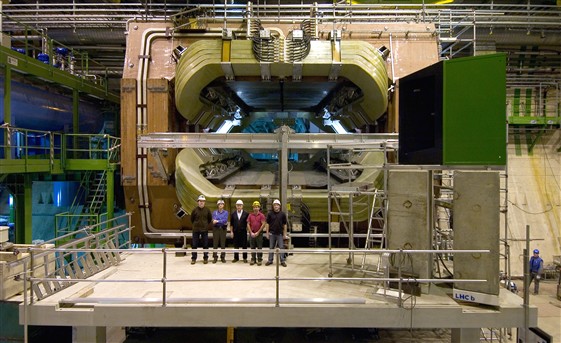An experiment at the Large Hadron Collider (LHC), the world's largest particle accelerator, has revealed the first evidence for a phenomenon known as charge-parity (CP) violation in the decays of subatomic particles called charm quarks. The results could help researchers get closer to explaining why matter dominates over antimatter in the universe, enabling galaxies, stars, planets, and—ultimately—living organisms to exist. A key theory in physics, CP symmetry holds that physical laws should stay the same if a particle's electric charge is switched—that is, if a particle is swapped for its antimatter counterpart—and if the particle's spatial coordinates are inverted, presenting a mirror image of itself. See also: CP symmetry and its violation; Electric charge; Parity (quantum mechanics); Symmetry breaking; Symmetry laws (physics)

Most particles demonstrate CP symmetry. However, since the 1960s, scientists have compiled a growing list of particles that break it. This violation manifests as particles decaying in a way that ultimately favors matter production over antimatter production. Researchers therefore study CP violation to attempt to answer why the universe forged more matter than antimatter during the big bang nearly 14 billion years ago. Had the two substances formed in equal amounts, as big bang models suggest they should have, the universe would have remained a sea of energy, because matter and antimatter annihilate each other upon contact. See also: Antimatter; Big bang theory; Elementary particle; Matter
Probing the primordial matter-antimatter imbalance is a chief rationale for the LHCb experiment, in which CP violation has been observed. Located at the LHC, near Geneva, Switzerland, the LHCb is a massive detector apparatus wrapped around the tube that runs through the LHC's 27 km (17 mi) underground ring. Inside this tube, accelerated protons collide at nearly the speed of light. The tremendous energies of these collisions spray the LHCb detector with short-lived particle configurations, whose decay products can then be traced back to parse the underlying physics involved. Particles containing charm quarks sprung forth from the billions of collisions recorded by the experiment over the LHC's most recent operational run, from 2015 to 2018. See also: Collision (physics); Large Hadron Collider (LHC)
An analysis of charm quark decays revealed that, in rare instances, CP violation occurred, leading to skewed generation of secondary particles containing antiquarks, the antimatter versions of quarks. Along with the charm quark, to date, researchers have now documented CP violation in two other quarks, named strange and bottom. Those two quarks carry an electric charge of −⅓; the charm quark, with a +⅔ charge, is the first positively charged quark to demonstrate CP violation. (Quarks, six kinds of which exist in total, are a fundamental building block of matter, making up the everyday particles called hadrons that include ubiquitous protons and neutrons.) See also: Fundamental interactions; Hadron; Neutron; Proton; Quark
The extent of CP violation is relatively small. And in combination with all other such violations discovered to date, the new charm deviance does not come remotely close to resolving the matter-antimatter disparity. Investigating this novel example of CP violation, though, will further test the standard model of particle physics. While remarkably successful, the standard model is incomplete. It fails to explain the properties of particles called neutrinos, the force of gravity, and the entities of dark matter and dark energy, which together represent about 95% of the universe’s total composition. Whatever might help scientists see beyond the limitations of the standard model is therefore welcome. See also: Dark energy; Dark matter; Gravity; Neutrino; Standard model; Universe





